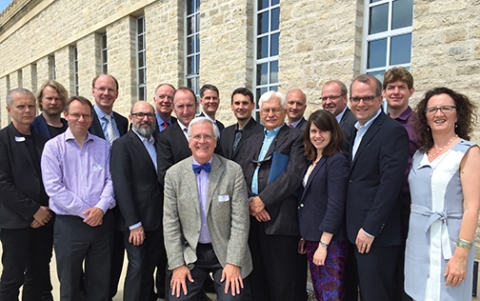
Global consortium forms to standardize and improve sharing and displaying of image-based scholarly resources on the web
Leaders from eleven research libraries, national libraries, and nonprofit image repositories met at Oxford University to form the International Image Interoperability Framework Consortium.
Access to image-based resources is fundamental to research, scholarship and the transmission of cultural knowledge. Until now, much of the Internet’s image-based resources have been locked up in silos, with access restricted to custom-built applications. The International Image Interoperability Framework (IIIF) supports uniform display of images of books, maps, scrolls, manuscripts, musical scores and archival material from participating institutions for display, manipulation, measurement and annotation by scholars and students working individually or in groups around the world.
The IIIF initiative was conceived on the back of a napkin at a Cuban restaurant in Palo Alto, California at a dinner of technologists from the Bodleian Libraries at Oxford University, the British Library and Stanford University Libraries. Yesterday, eleven institutions committed resources and officially formed the International Image Interoperability Framework Consortium (IIIF-C), which will oversee the ongoing development of the IIIF technology as well as the growth of the community.

Joining Oxford, the British Library and Stanford as part of the IIIF-C are ARTstor, Die Bayerische Staatsbibliothek (The Bavarian State Library), Cornell University, La Bibliothèque nationale de France (The National Library of France), Nasjonalbiblioteket (The National Library of Norway), Princeton University Library, Wellcome Trust and Yale University (Yale Center for British Art, Beinecke Rare Book & Manuscript Library).
“For the past quarter of a century the emphasis has been on ambitious programs of mass digitization, reproducing, and in many cases preserving, millions of cultural and historical artifacts,” said Michael Keller, university librarian at Stanford Libraries. “With IIIF we turn our attention to making those digital surrogates more easily accessed and compatible with scholarly applications. No one institution can or should do this alone, for the talent of the collective is required to scale and sustain this initiative,” concludes Keller.
The IIIF-C aims to reduce inefficiency and needless redundancy born from incompatibility in the current image delivery ecosystem. The framework includes two application programming interfaces (APIs). The Image API provides access to the image content and technical descriptions. The Presentation API gives just enough structural and descriptive information about the image's context to appropriately render it in an arbitrary, web-based, viewing environment.
While IIIF’s origins are in libraries, the community is rapidly expanding to include museums, archives and image services of all types, creating new opportunities for exchange and collaboration across sectors. In addition to the founding IIIF-C members, 20 other institutions are contributing to discussions on specifications for interoperability and providing both open source and commercial implementations of the APIs currently available.
By adopting the IIIF and becoming part of the community, institutions gain access to well supported and sustainable technologies, and enrich scholarly use of their materials. For more information, visit the IIIF website.
About Stanford Libraries
The Stanford University Libraries (SUL) is more than a cluster of libraries; it connects people with information by providing diverse resources and services to the academic community. SUL includes more than 20 individual libraries across campus, each with a world-class collection of books, journals, films, maps, databases, and more.
Stanford Libraries’ Digital Library Systems and Services (DLSS) is the unit primarily involved with IIIF. Recognizing the ongoing need to position itself for the digital future, Stanford Libraries created the DLSS group in 2004. DLSS is the information technology production arm of the Stanford Libraries; it serves as the digitization, digital preservation and access systems provider for SUL; and it is the research and development unit for new technologies, standards and methodologies related to library systems.
About IIIF
The IIIF is driven by a group of research libraries, national libraries, and nonprofit image repositories committed to opening access to cherished image resources. IIIF (International Image Interoperability Framework) has the following goals:
- To give scholars an unprecedented level of uniform and rich access to image-based resources hosted around the world.
- To define a set of common application programming interfaces that support interoperability between image repositories.
- To develop, cultivate and document shared technologies, such as image servers and web clients that provide a world-class user experience in viewing, comparing, manipulating and annotating images.
Press Contact
Gabrielle Karampelas, Stanford Libraries, 650-492-9855

 Stanford University Home
Stanford University Home